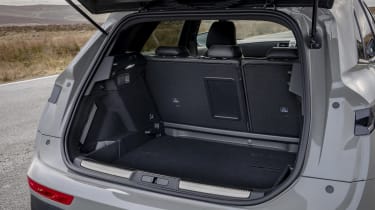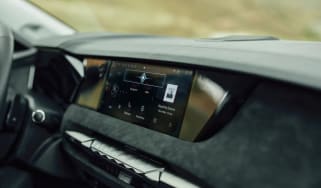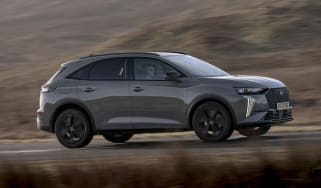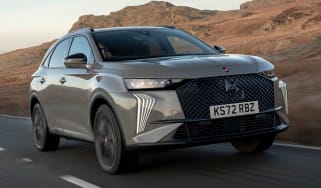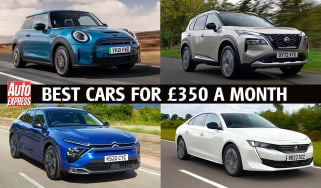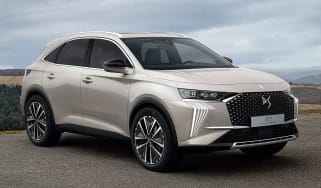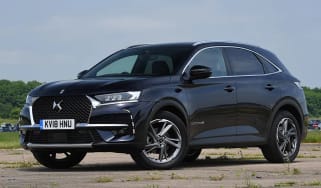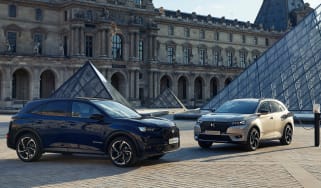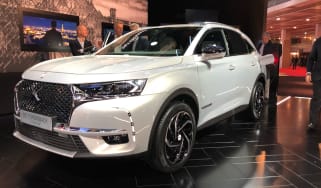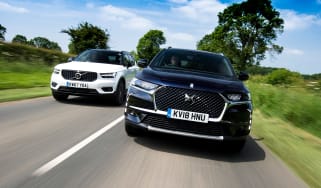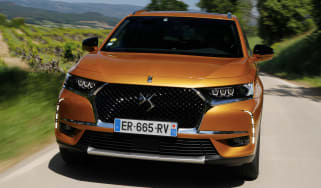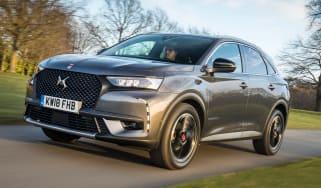DS 7 review
The DS 7 SUV offers a touch of French luxury to take on its established German rivals

The DS 7 competes in a market sector that’s chock-full of talented rivals, but it doesn’t boast class leading qualities in enough areas to be considered a serious contender. It’s an interesting car with a well-appointed, classy interior and plenty of eye-catching features. If you’re looking for a mid-size SUV that’s out of the ordinary and feels special inside, this could be it.
It’s spacious too, but it doesn’t drive anywhere near as sharply as many rivals. The inconsistent ride also means it fails to fulfil its brief as a supremely comfortable French cruiser. Ambitious asking prices mean that there’s no real financial advantage in picking the DS 7 over the alternatives from the premium SUV establishment, either.
About the DS 7
The DS 7 is a roomy mid-size SUV aimed at the upper end of the market. It focuses on offering something different from the norm and largely succeeds. DS, the Stellantis Group premium brand, would tell you that its product delivers ‘French luxury’ in a class where most adopt the more clinical approach typified by the German offerings.
The DS 7 sits above the DS 3 and DS 4 in the manufacturer’s model line-up but it’s not a giant leap up in size from those cars. It uses a version of the Stellantis EMP2 platform that underpins the DS 4 and is shared with the likes of Peugeot’s 3008, the Vauxhall Grandland and the Citroen C5 Aircross. Key rivals for the DS 7, given its premium positioning and pricing, include cars like the Volvo XC40, Jaguar E-Pace, BMW X1 and Audi Q3. Although it is a little larger than these models.
The DS 7 was on the receiving end of a far-reaching facelift in 2022 that also saw it become the plain-old DS 7 rather than the DS 7 Crossback. The current car is marked out by headlights featuring ‘Pixel LED Vision 3.0’ technology that offers different settings for different road conditions. The striking DS Light Veil daytime running lights extend down from those main light units in the form of five curved lines.
At the back, DS added more body creases for a wider look and slimmer LED lights. Elsewhere, a 12-inch infotainment screen dominates the upgraded cabin in combination with a 12.3-inch digital instrument cluster. The battery pack on the plug-in hybrid models was also expanded from 13.2kWh to 14.2kWh.
The DS 7 has always used its impressive arsenal of technology features to separate itself from the competition. There’s Active Scan Suspension on the plug-in models that ‘reads’ the road ahead and adjusts the dampers to suit, adaptive cruise control that can bring the car to a halt and set it moving again in traffic, plus other kit like a driver monitoring camera, night vision and a head-up display, on some models.
There's a choice of three E-Tense plug-in hybrid petrol engines and a diesel, all using four-cylinder combustion units. The BlueHDi 130 diesel is the cheapest way into a DS 7 by over £7,000 and comes in front-wheel drive form with the EAT8 eight-speed automatic gearbox.
The plug-in hybrids open with the e-Tense 225, another front-wheel drive model with 222bhp. Above that, it’s four-wheel drive all the way with the E-Tense 300 packing 292bhp and the E-Tense 360 which has a punchy 350bhp. That flagship 360 model also comes with suspension changes by DS Performance including upgraded springs and dampers as well as a wider track.
These days there are five trim levels for DS 7 buyers to mull over. Sporty Performance Line and Performance Line + variants lead into the more luxurious Rivoli, Opera and La Premiere models, the latter only available with the E-Tense 360 powertrain.
Standard kit for the entry-level Performance Line cars includes 19-inch alloy wheels, keyless entry and start, the DS Iris infotainment system (3D connected navigation, voice recognition and over-the-air updates), Apple CarPlay, Android Auto and a black Alcantara and vinyl leather interior. The Performance Line+ adds black roof rails outside, parking sensors, a reversing camera, electric heated seats and a heated windscreen for about £2,700, which many will see as a worthwhile upgrade.
With the Rivoli model you get a cabin trimmed in black leather chrome roof rails, massaging front seats and the DS 7’s trademark ‘B.R.M R180 Timepiece’ – a clock that folds out of the dash when you start the car. It’s only about £1,200 more than the Performance Line+.
Opera is a £3,500 jump and only available with the E-Tense powertrains. Here the front seats are ventilated, there’s the DS Drive Assist adaptive cruise control, an electric tailgate, a panoramic sunroof plus two extra USB ports and a wireless charging mat. Finally, the La Premiere trim has the full house of DS 7 features including 21-inch wheels, a 360-degree reversing camera, a Focal Electra stereo upgrade, the Night Vision system and hands free access for the electric tailgate. It’s only offered with the E-Tense 360 engine and it costs a considerable £63,000.
Engines, performance and drive
The DS 7 focuses on offering a comfortable drive rather than a particularly thrilling one but it’s only moderately successful in that. The ride can be inconsistent with the car often pitching and bouncing over imperfections in the road surface – struggling to settle.
Like many rivals, the DS 7 comes with a number of driving modes and the default mode is ‘Normal’. But if you want the Active Scan Suspension fitted on the plug-in hybrid models to actually do its thing, you’ll have to jab the diamond-shaped drive mode selector switch and change to ‘Comfort’. Do this and the DS 7 becomes far more comfortable (as you’d expect) – the camera does a good job of scanning the road and tweaking the damping at road speeds of around 30-40mph, but the low speed ride remains noticeably inconsistent and picks up judders too frequently. It can feel a little wallowy at speed on motorways, too.
Flicking the car into Sport mode reveals that the DS 7 isn’t an SUV prepared to be driven swiftly, with sub-par body control and light, lifeless steering. The artificial engine sound actuation induced in Sport mode will quickly get on your nerves but all DS 7 models are otherwise well soundproofed against wind and road noise.
There is an exception to all this, however, because the E-Tense 360 flagship model gets a different chassis configuration tuned by DS Performance. Revised springs and dampers plus a wider track really do make a big difference to the way the DS 7 drives. There are still some question marks over the low speed ride, which can partly be attributed to the standard 21-inch wheels on this version, but things get a lot better as speeds rise. In this specification the DS 7 resists body roll far more effectively and gains a much more nimble feel. It’s a shame that similar tweaks couldn’t have been made across the range. The steering is heavier as well, but still lacks any feedback.
0-62mph acceleration and top speed
These days, DS 7 buyers can either choose diesel or an E-Tense petrol plug-in hybrid. The oil-burner, predictably, is the budget option – it's a 1.5-litre, 129bhp unit that delivers 300Nm of torque at 1,750rpm. Powering the front wheels and paired with the EAT8 automatic gearbox, it can cover the 0-62mph sprint in 10.7 seconds and the top speed is 121mph. It doesn’t do too badly for refinement, settling nicely while cruising, but unfortunately revealing a trademark, coarse diesel growl when pushed.
The main focus of the DS 7 range is on plug-in hybrid power with the same E-Tense system available in 225, 300 and 360 forms. Power outputs are 222bhp, 292bhp and 350bhp respectively. While the E-tense 225 is front-wheel drive and delivers a maximum torque output of 360Nm, the 300 and 360 models are both all-wheel drive with a more muscular 520Nm on tap. We’ve spent a lot of time testing both the 225 and the 360 versions in the UK and in Europe.
The 225 model is going to feel fast enough for most requirements and it’s doubtful that many of the DS 7’s target market will be particularly desperate to have four driven wheels – this is definitely no off-roader. It can cover the 0-62mph sprint in 8.9 seconds before going on to a 140mph top speed. The gearbox shifts smoothly but there are moments of indecision when the system switches between power sources. Generally, performance feels stronger than the numbers suggest from low speeds thanks to the electrical assistance.
That said, the E-tense 300 is notably quicker, recording 5.9 seconds for 0 to 62mph and a 146mph maximum. It’s just as hushed when cruising but also has the same tendency to sound strained at the top of the rev range, something that’s exacerbated by the over-eagerness the gearbox shows to change down in response to even moderate throttle inputs.
The E-Tense 360 has more power thanks mainly to software changes but the top speed and acceleration numbers are the same. The big differences are the suspension tweaks and bigger brakes you get on this model. If you want the best DS 7 to drive this is it but we suspect the 225 E-Tense or even the diesel are the best fit for most buyers.
MPG, CO2 and Running Costs
If you can see past the expensive list prices of the DS 7 compared to its more established premium rivals, possibly because you’re leasing one or choosing it as a company car, running costs shouldn’t be too bad.
The BlueHDi turbo diesel is rated at 49 to 53mpg on the WLTP combined cycle with CO2 emissions between 100 and 106g/km. With the E-Tense options, the usual caveat that plug-in hybrid efficiency depends greatly on how often you charge the battery is needed but the 225 can officially return between 178 and 250mpg, the 300 is in the 193 to 250mpg ballpark and the 360 is significantly lower at 161mpg. All versions are in the 26 to 40g/km range for CO2 emissions.
Electric range, battery life and charge time
The DS 7 E-Tense's battery has grown to 14.2kWh in the latest models and this saw the quoted maximum electric driving range increase to 43 miles in the 225. Our testing indicates that you can probably expect to achieve something in the low to mid thirties. The 4x4 E-Tense 300 is only a single mile down with a 42-mile maximum range but the 360 can only manage 36 miles on the official tests.
The E-Tense 225 model only has a 3.7kW on-board charger as standard, meaning it'll take roughly three hours to fully recharge the battery from a home wallbox. The 300 and 360 models can charge at up to 7.4kW, so you can get a 100% charge in an hour and 45 minutes. In all cases, you’re looking at seven hours for a full charge from a standard three-pin socket. The regenerative braking system is controlled via a button on the gear lever and can add up to 20% to the electric range in urban traffic, according to DS.
Insurance groups
In entry level Performance Line trim, the BlueHDi diesel occupies insurance group 26 while the E-Tense 225 is in group 34. At the top of the range, the E-Tense 360 La Premiere is in group 42. For comparison, the diesel Jaguar E-Pace starts in group 28 while a PHEV in plush R-Dynamic spec is also in group 42.
Our Car Tax Checker tool lets you check your tax status and renewal date in seconds. Check your VED car tax now...
Depreciation
Predicted residual values aren’t too alarming but the most popular and in-demand versions of key rivals such as the Jaguar E-Pace and Audi Q3 make for better reading, and the DS 7’s worth after three years and 36,000 miles also lags behind the Volvo XC40.
DS 7 values are all in the region of 48 per cent of the car’s original asking price so trim and engine don’t make a huge amount of difference. The Volvo XC40 models with internal combustion engines range from 57 to 61 per cent however, while the Jaguar E-Pace will still be worth 56 to 60 per cent of its original value.
To get an accurate valuation on a specific model check out our free car valuation tool...
Interior, design and technology
As the first true DS product in its own right, the DS 7 showed us what the French firm’s design team could do when presented with a blank sheet of paper. It sits on the Stellantis Group’s EMP2 platform, shared with the Peugeot 3008, Citroen C5 Aircross and Vauxhall Grandland.
At launch it revealed a relatively clean and conventional look but the 2022 facelift brought a little bit more visual interest in the form of those striking DS Light Veil daytime running lights that drop like fangs from the headlight units and some sharper creases around the tailgate.
Looking at the car’s side profile reveals a tall beltline mated to rounded roof and rear window lines. There’s less chrome on the latest cars for a less busy appearance, although there’s still probably too much badging on the rear end with ‘DS Automobiles’, ‘DS’, ‘DS 7’ and (on the hybrids) ‘E-Tense’ logos all squeezed in and using various different fonts.
The car’s interior is more interesting still. The cabin is dominated by a large centre console, which pours down seamlessly from the dashboard and cocoons both the driver and front passenger in their own separate areas. Material quality is on par for the premium SUV class at hand height, but you’ll be disappointed to see that the angular, metallic looking switchgear lining the centre console is actually plastic. Lower quality plastics can also be found if you go looking for them.
Sat-nav, stereo & infotainment
As standard, the Performance Line model features a 12.3-inch digital instrument cluster and a 12-inch HD touchscreen. The system runs the DS Iris software with a widget-based user interface and features DAB digital radio, Bluetooth, Apple CarPlay and Android Auto. It’s capable of receiving over-the-air updates, too.
Connected navigation is also offered across all variants, as are two rear USB sockets and an eight-speaker audio system. Wireless charging comes on the Opera models while an upgraded Focal Electra stereo with 14 speakers and a subwoofer comes on the La Premiere cars.
The system is straightforward enough, although there are menu systems out there that are easier to grasp quickly. The graphics are crisp and the touchscreen is responsive. It’s helpful to have a single view which shows map and climate controls because the shortcut keys under the screen can be tricky to use.
Practicality, comfort and boot space
The DS 7 slips into the more compact end of the premium SUV market alongside the Audi Q3, Jaguar E-Pace and Volvo XC40. The avant-garde cabin seats five and no more.
The driving position is nothing out of the ordinary for an SUV, perching the driver high for a decent view of the road. Visibility front and sideways is good but, as is the case with many models in the current crop of increasingly rakish SUVs, the rear window isn’t the largest. Though it’s clearly a design-led SUV product, Performance Line+ cars upwards come with roof rails as standard, and a tow bar is available on the options list.
Dimensions and size
Against the tape measure the DS 7 sizes up at 4,593mm long, 1,625mm high, 1,890mm wide and boasts a wheelbase of 2,738mm. That means it’s longer than the Volvo XC40, Jaguar E-Pace, BMW X1 and Range Rover Evoque, boasting a lengthier wheelbase than those cars too. Both the Evoque and the E-Pace are a little wider, while the 1,625mm height means that the DS 7 isn't one of the tallest options in the pack. It is, however, taller than rivals that take more of a crossover approach such as the BMW X2 and Mercedes GLA.
Leg room, head room & passenger space
Inside, the DS 7’s level of front and rear kneeroom is decent, generous even. The tall, rounded roof means headroom is good, but equipping the panoramic glass roof intrudes on this. In the back, the floor feels just ever so slightly shallow and could impact comfort for taller passengers, but the transmission tunnel is completely flat and doesn’t intrude on the middle seat where kneeroom is still excellent.
Boot space
Open the tailgate and you're greeted with a 555-litre boot, accessed by a wide and low opening. It’s a generous size for the class, roundly beating the Volvo XC40 and other SUVs with similar footprints such as the Audi Q3 and Range Rover Evoque. To put things into perspective, the 555-litre space even shades out the larger Audi Q5. The seats don’t fold completely flat, but lowering the back row opens up a large 1,752-litre cargo area.
The hybrid models have exactly the same boot capacities as the diesel and the variable height boot floor allows you to choose either a flat floor or a larger space with a slight loading lip.
Towing
A manual tow bar can be fitted to the DS 7 and is available as an optional extra on every model, priced at £800. All models boast an unbraked towing capacity of 750kg but the diesel can tow a 1,430kg braked trailer compared to 1,200kg for the hybrids.
Reliability and safety
The DS 7 has run the Euro NCAP gauntlet and emerged with a full five-star rating, notching up a 91 percent score for adult occupants and 87 percent for child occupant protection. A pedestrian safety rating of 73 percent is impressive, while a decent amount of standard safety kit results in a 76 percent score in that field too.
Standard convenience tech includes cruise control with a speed limiter function, traffic sign recognition, hill start assist and rear parking sensors. There’s also the Pixel LED Vision headlights that adapt to different driving situations, blind spot detection, lane keeping assist and driver attention alert. Opera models get DS Driver Assist, the intelligent cruise control system that will keep the car in its lane and maintain distance to the car ahead, even slowing to a stop in traffic before pulling away again when needed.
Neither the DS 7 or the DS brand itself made an appearance in our latest Driver Power owner satisfaction survey rankings, however, in past editions customers highlighted significant concerns with the quality of the brand's products. There was some positivity towards the overall driving experience and fuel economy, but criticism for harsh ride quality and poor practicality too.
Warranty
The standard DS warranty lasts for three years and is limited to 60,000 miles. For a fee, the warranty can be extended to five years. A 12-year anti-perforation warranty is also included, alongside a three-year guarantee on the paint. All in all, it’s a fairly standard offering.
Servicing
DS offers a range of regular service plans, paid for monthly or in a lump sum as well as various fixed price repairs. Two- three-, four- and five-year plans are available.


